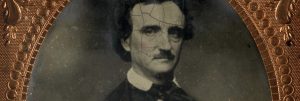In the Shadows of Rue Morgue: An Annotated Exploration into Detective Fiction’s Roots (Piper Wiley)
Introduction
By Piper Wiley

Edgar Allan Poe is widely regarded as the father of detective fiction, a genre that emerged from Gothic fiction traditions. His 1841 story “The Murders in the Rue Morgue” is the first example of a fictional detective story. Poe established many of the conventions and elements that would define the detective story for generations to come. In this annotated edition, I will explore the influences of Poe’s detective story, as well as the elements that came to define the genre.
The text I have chosen for this edition is the original manuscript that Poe prepared for the story’s first publication in Graham’s Magazine known as the “Johnston” manuscript. This manuscript was saved from destruction by J. M. Johnston, an apprentice at the printing firm that worked for Graham’s Magazine, who kept it for about forty years before selling it. It then passed through several hands until it was donated to the Free Library of Philadelphia in 1974. This manuscript is the closest we can get to Poe’s original vision and intention for “The Murders in the Rue Morgue”, and it allows us to see how he revised and edited his story for subsequent publications.
Source Text:
Poe, Edgar A. “Edgar Allan Poe, ‘the Murders in the Rue Morgue’ (Text-02a), ‘Johnston’ Manuscript, Early 1841.” Edgar Allan Poe Society of Baltimore, https://eapoe.org/works/tales/morguea.htm.
